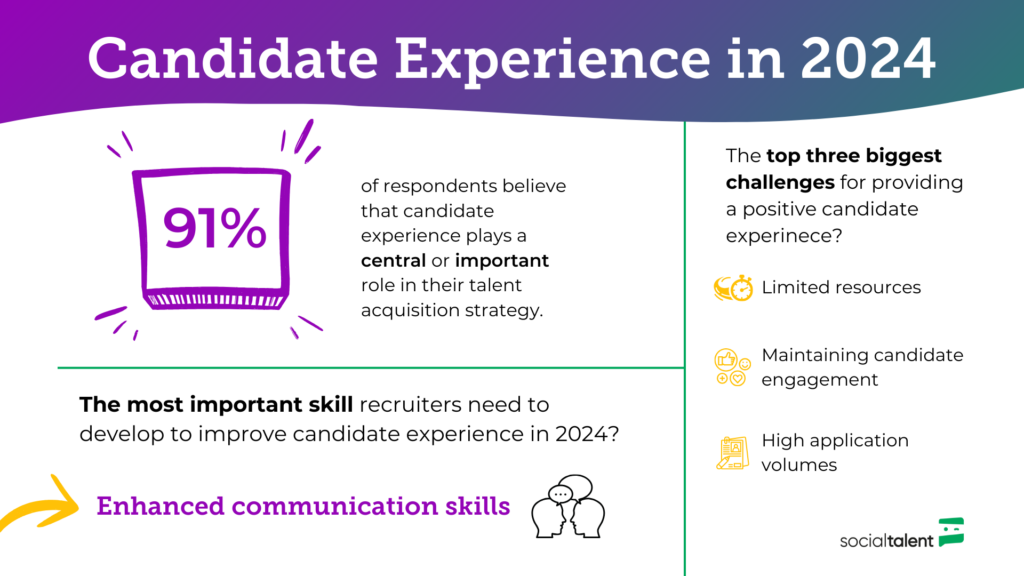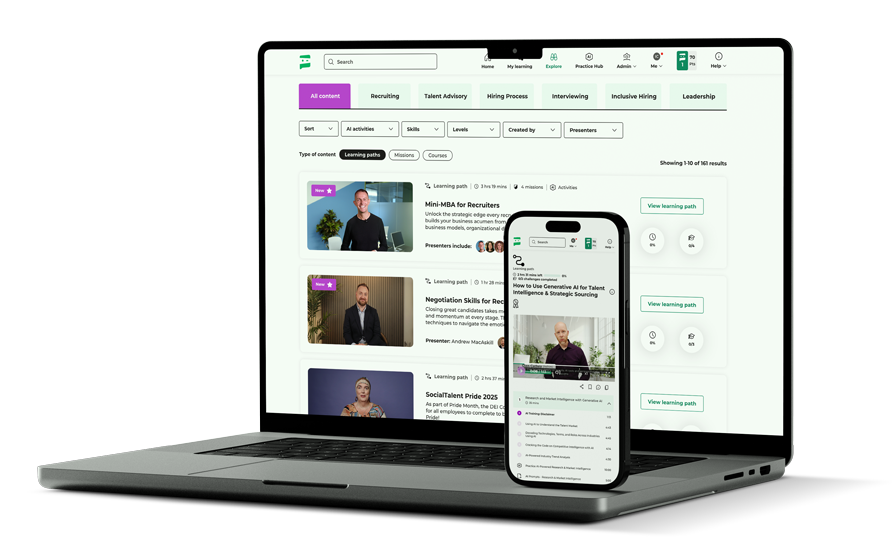
By David Deady
In an increasingly competitive job market, candidate experience has become a critical factor that can make or break an organization’s ability to attract top talent. With evolving expectations, technological advances, and a growing emphasis on human-centric recruiting, the way companies manage and deliver their hiring processes has transformed significantly. In 2024, candidate experience is no longer just a component of the recruitment process – it has become central to shaping employer brand and long-term talent strategy.
During SocialTalent Live, our recent industry event focused on “The Future of Candidate Experience,” we invited industry leaders and experts to explore the current landscape of candidate experience and provide actionable insights on what organizations can do to meet candidate expectations today. But we also ran a number of polls with our audience to get an on-the-ground temperature check on what the current state looks like. And here are the major findings:

From the central importance of candidate experience in the talent acquisition strategy and the role of communication in creating a positive journey, to the unique challenges organizations face in managing candidate engagement, especially when operating with limited resources and handling high application volumes, we got a pretty clear picture about what candidate experience looks like right now. But let’s dig a little deeper!
1. The Importance of Candidate Experience in the Hiring Process
With over 90% of our audience stating that candidate experience plays a central or important role in their TA strategy, the days when it was considered a secondary part of recruitment are long gone. Today, candidate experience sits at the core of successful talent acquisition strategies, shaping how an organization is perceived by potential hires. As Johnny Campbell, CEO of SocialTalent, noted at the beginning of the event, “Creating a positive and memorable candidate experience has never been more important.” In an environment defined by talent shortages and heightened expectations, organizations that ignore this critical aspect of recruitment risk losing out on top talent.
Candidate experience isn’t just about making a good impression on those who receive offers either; it’s about crafting a holistic, fair, and engaging process for all candidates – whether they land the role or not. Kevin Grossman, ERE Media’s VP of Research, highlighted the significant impact candidate experience is having right now. He explained that poor experiences can foster resentment and frustration, which have long-lasting effects on how potential candidates perceive and engage with a company. #
“Candidate frustration and resentment are higher than they’ve ever been,” Kevin emphasized, underscoring the fact that organizations must proactively address these concerns if they want to stay truly competitive in the talent market.
Moreover, Tom Sayer, Global Recruiting Director at Accenture, shared how important personal interactions are in creating positive candidate experiences. While many aspects of the recruitment process can be automated, human touchpoints are often what candidates remember most. “The peak of the experience comes when candidates meet our people,” Tom said, reaffirming that human interaction remains key to creating a lasting, positive impression.
2. The Role of Good Communication in Positive Candidate Experience
At the heart of every great candidate experience is communication. From initial outreach to post-interview feedback, how companies communicate with candidates can either enhance or detract from the overall experience. Transparent, timely, and honest communication helps candidates feel valued, even if they don’t get the job.
Cheryl Peterson, Associate Principal and Regional Talent Resourcing Leader at Arup, emphasized the importance of providing real-time feedback to candidates. In response to candidate surveys, Arup implemented structured interview debriefs with 24-hour service-level agreements (SLAs) to ensure candidates received prompt updates. “We heard loud and clear from our survey results that candidates wanted immediate feedback to know where they stood in the process,” Cheryl said. This simple yet effective approach has significantly improved candidate satisfaction by setting clear expectations and minimizing uncertainty.
Communication also plays a crucial role in framing the use of technology during the hiring process. As companies increasingly leverage AI and automation to handle tasks like application screening and interview scheduling, transparency around how these tools are used becomes essential. Candidates often feel uneasy about the impersonal nature of automation, but Cheryl explained that Arup found success by openly communicating the benefits of automation. “Candidates want to know that automation isn’t being used to weed them out, but rather to bring them in for human conversations,” she said. By proactively framing technology as an enabler rather than a barrier, Arup has been able to maintain a personal touch even while managing high application volumes.
Tom echoed these sentiments, sharing that Accenture uses ongoing feedback mechanisms to ensure communication remains consistent throughout the hiring journey. Instead of relying solely on post-process surveys, Accenture pulses candidates at various stages of the application process, allowing for real-time adjustments. “Candidates just want transparency and to know why things are done a certain way,” he said, highlighting how communication fosters trust and creates a more positive experience.
3. Challenges: Limited Resources, Managing Candidate Engagement, and High Application Volumes
While enhancing candidate experience is a top priority, organizations often face significant challenges in achieving this goal – especially when dealing with limited resources and high application volumes.
One of the most common challenges, as revealed by the poll we conducted during the event, is managing candidate engagement. With reduced budgets and smaller hiring teams, many organizations struggle to maintain personalized interactions throughout the process. Cheryl noted that balancing technology with human touch is critical, but it’s also a significant challenge when hiring at scale. At Arup, they tackled this by automating initial stages such as pre-recorded video interviews but supplemented this with personal follow-ups and clear communication at key moments.
Tom Sayer shared how Accenture handles the massive challenge of managing over 5 million applications annually. With such high volumes, automation becomes necessary for screening and scheduling, but the company makes a concerted effort to balance automation with human interaction at critical stages. Tom emphasized that technology should be seen as an enabler that allows recruiters to focus on meaningful interactions. “The focus remains on meaningful human interactions during key moments like interviews,” he explained, stressing that automation should not replace but rather augment the human elements of the hiring process.
For Gui Neves, Global Talent Acquisition Manager at Nestlé, handling high volumes is a daily challenge. Nestlé receives over 6 million applications every year, and while only a small fraction of candidates make it to the interview stage, they ensure that all candidates, even those who are rejected, feel valued. Neves explained how Nestlé provides educational resources to rejected candidates, turning the disappointment of rejection into a positive learning opportunity. “We provide specific training content to candidates as a takeaway from their interaction with us,” Neves said, highlighting how Nestlé seeks to engage candidates even after they exit the recruitment process.
Learn more: How to Build the Perfect Candidate Experience
The Path Forward
In 2024, the landscape of candidate experience is defined by a balance between technology and human interaction. As automation becomes more widespread, organizations must remain vigilant in maintaining the personal, human touch that candidates value most. Communication, transparency, and timely feedback are the cornerstones of a positive candidate experience, while managing engagement and handling large application volumes present ongoing challenges for organizations of all sizes.
The consensus from SocialTalent Live is clear: candidate experience is no longer an afterthought but a crucial element of the hiring process that directly impacts an organization’s brand, reputation, and ability to secure top talent. As companies navigate limited resources and increasing applicant numbers, those that can successfully combine technological efficiency with meaningful human engagement will stand out as employers of choice in this competitive talent market.




